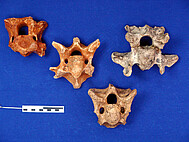Main Research of the Palaeontology and �Evolution section
Despite the fact that palaeontology and evolution are closely related fields of research, both disciplines diverge in their objectives. Palaeontology mainly deals with fossil organisms from different times and a variety of locations. By contrast, research on evolution aims to reconstruct the transformation of animals and plants over time to the current day based on fossil evidence. Both disciplines of research are mostly funded by externally financed projects. This allows us to maintain an internationally high research profile with the help of PhD students and guest researchers even though there is only full-time staff member. There are regional and cross-regional research projects, nearly all of which are internationally interlinked. The research objectives and results are not only applied to current exhibits but also to teacher and student education as well as university teaching at the KIT.
The ice age at Upper Rhine
The ice age collection is the largest part of the palaeontological collections. The material comes from almost the entire Upper Rhine with the oldest specimens hailing from the collections of Margravine Karoline Luise of Baden. Ice age research is not only carried out in-house: the collection is also frequented by international guest researchers. The material of the Mauer Sands forms part of a current research project. Here, we work in close conjunction with the Excellency University of Heidelberg and the association Homo heidelbergensis von Mauer e.V.. We also have a joint venture with the University of Heraklion, Crete.
Neogene life along the Upper Rhine
We and our partners are currently studying two localities in Baden: the Unterfeld clay pit at Rauenberg (Early Oligocene, 32 Ma) and the Höwenegg site (Late Miocene, 9 Ma). Both localities yield assemblages of fossils which provide information on the evolution of individual animal groups in the area of what is now Baden, as well as on the changes of entire ecosystems during a global climate change in the course of the Neogene.
The Unterfeld clay pit:Since the early 70s the clay pit has been studied as part of a DFG-funded project supervised by Prof. Laszlo Trunkó. The clays in the pit were deposited 32 Ma ago along the coast of the Rupelian Sea that connected the Boreal Sea with the Paratethys in the south via the Rhine Graben. The black flaky clay contains numerous fossils, some of which have been excellently preserved. Fish make up the lion's share, whilst gastropods, bivalves, insects as well as birds, turtles and mammals are rarities. Plant remains are abundant. The clay pit was secured by the city of Rauenberg for future excavations. The current excavations are being conducted by experienced volunteers: Mr. and Mrs. Oechsler.
Höwenegg: The Miocene Höwenegg locality (MN 9) near Immendingen in the Hegau region is well known for its abundance of complete antelope, horse, and rhino skeletons, which were found in lake sediments in a volcanic context. Further mammal species, including various carnivores, chalicotheres, and relatives of elephants are represented by isolated teeth or bones. The locality also yields, amongst other things, remains of reptiles (especially turtles and tortoises), snails and other invertebrates, as well as diverse plant material. Since 2003, renewed excavations in the tradition of the classic field work at the locality in the 1950s and 1960s have been undertaken again every year.







